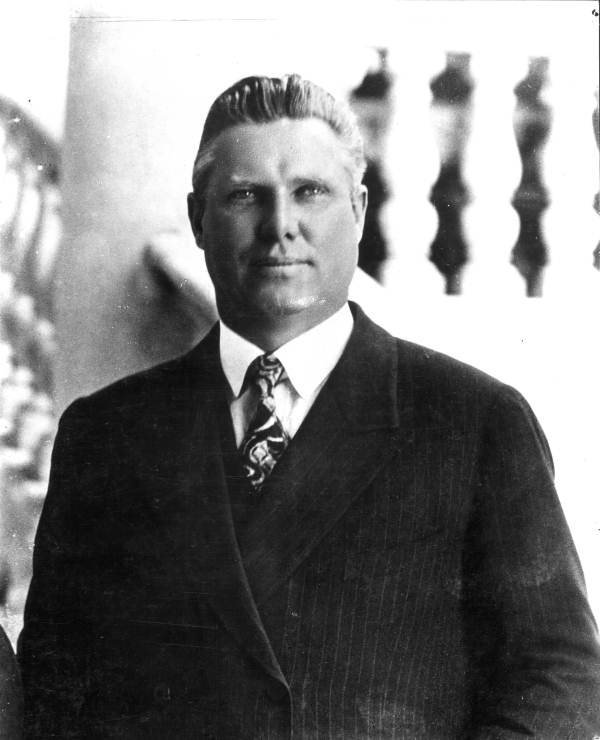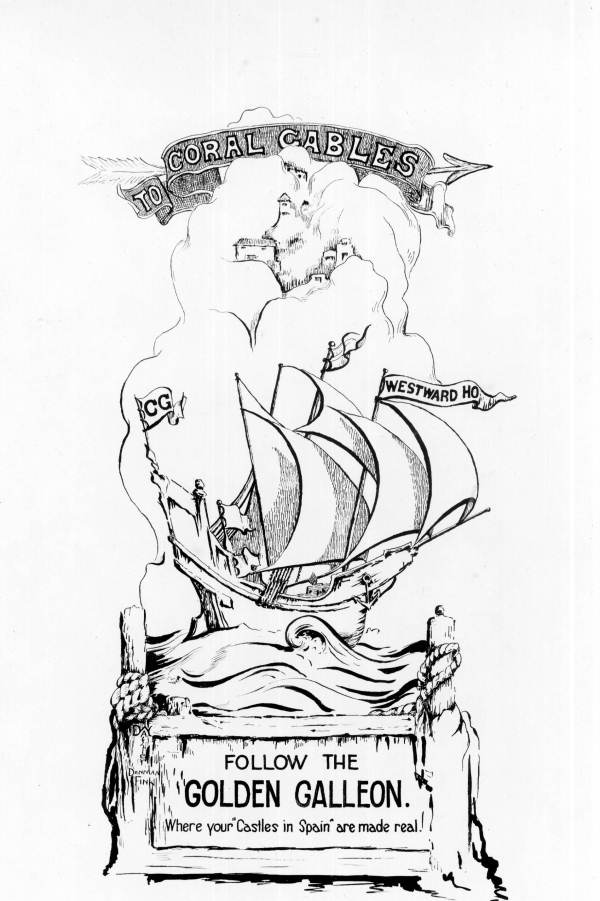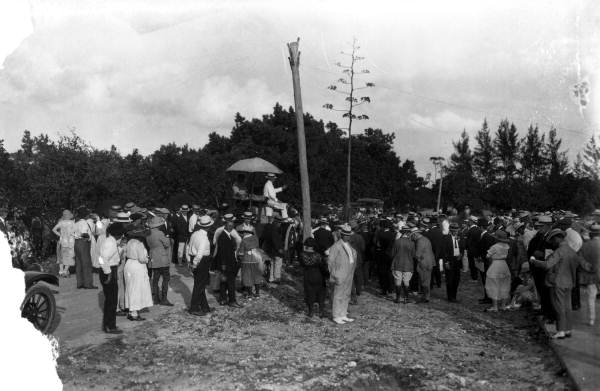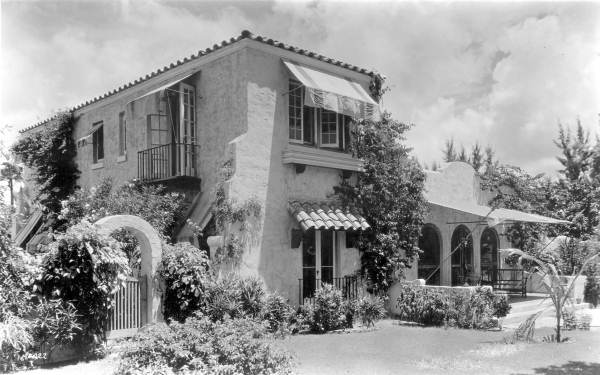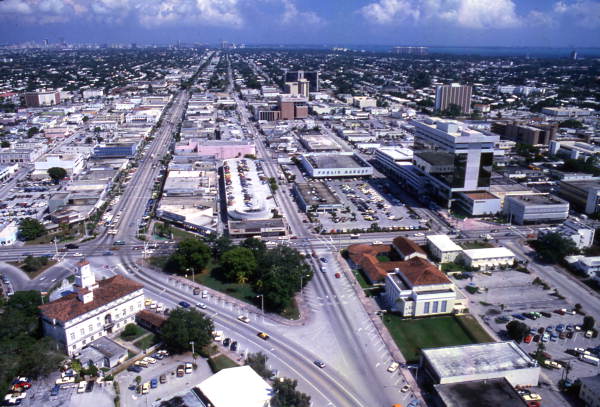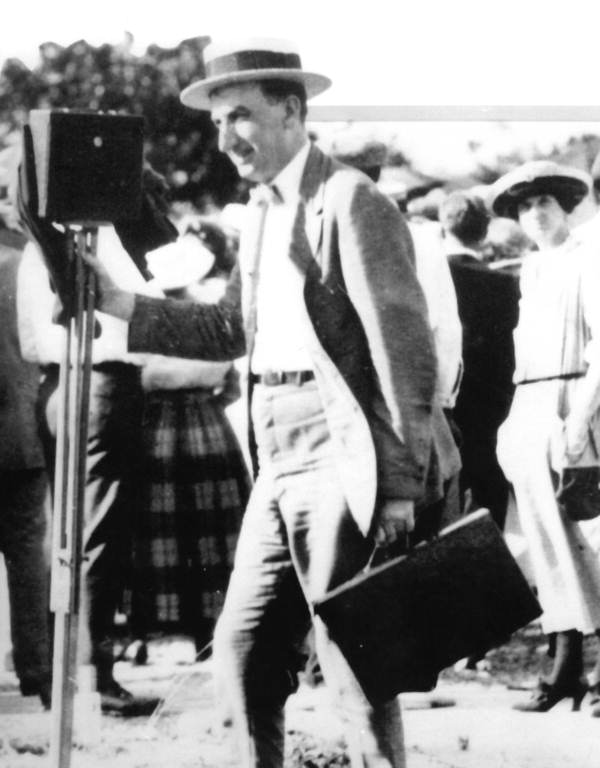Description of previous item
Description of next item
Miami's Master Suburb
Published September 9, 2018 by Florida Memory
Coral Gables started out as a family plantation with acres of grapefruit and avocado trees. By 1930, however, it had become a buzzing metropolis on the edge of Miami, with a flourish of Old World flair in its distinctive Mediterranean Revival architecture. Like most of the planned communities that emerged in Florida during the great boom of the 1920s, Coral Gables grew out of a vision–in this case one belonging to a young developer named George Merrick.
George Merrick arrived in Miami with his family in 1899. His father, Solomon Merrick, had been a minister in Duxbury, Massachusetts, but on the advice of a colleague in Coconut Grove he decided to move his family to Florida to try their hand at growing citrus on a 160-acre plot. Mrs. Merrick had wanted to name the plantation “Among the Pines,” but her husband preferred “Coral Gables,” a combined homage to both the local coral rock and the Massachusetts home of one of Solomon Merrick’s political idols, Grover Cleveland, which was called “Gray Gables.” The family decided to stick with the name Coral Gables Plantation, and soon it was being used in advertisements and signs.
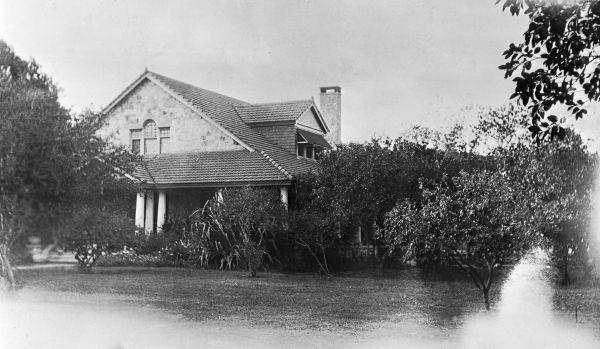
The original Merrick homestead, named “Coral Gables” after “Gray Gables,” the Massachusetts home of Solomon Merrick’s political idol Grover Cleveland. The “coral” part of the name stems from the local coral rock used as a building material (1926).
Solomon Merrick died in 1911, leaving 25-year-old George as head of the family and manager of the Coral Gables property. Under the young man’s management the plantation grew to 1,200 acres and employed more than 40 workers, but George believed Coral Gables could be something more. Real estate in Miami and Coconut Grove was booming, with rapid new construction along Miami Beach and in suburbs along the outer edges of town. George was deeply interested in getting involved with the lucrative business of real estate development, and in 1912 he partnered with his brother-in-law to start a real estate firm. The following year the fledgling business combined with the Realty Securities Corporation, making Merrick president of the largest real estate and development company in Dade County.
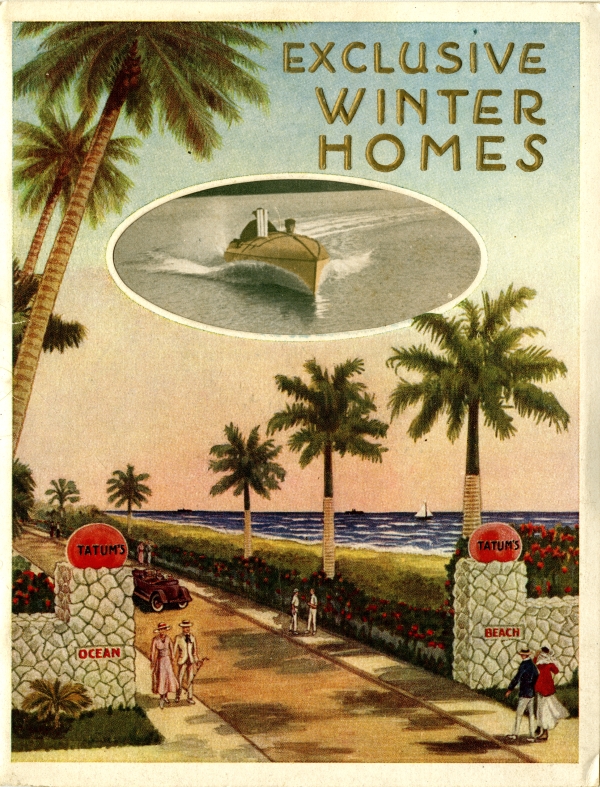
An example of one of the many booklets developed by Miami real estate developers in the 1910s and 1920s to entice northern buyers. This one was published by the Tatum Brothers Company to advertise their beachfront development north of Miami. Florida Collection, State Library (1918).
When George announced in 1918 that he planned to turn his family’s Coral Gables Plantation into a self-sufficient suburban village, many thought he had lost his mind. Even with Miami’s intense expansion, Coral Gables was still considered to be too far out of town, near if not in the Everglades. There were also other developments vying for the attention of home-seekers and real estate developers, namely Hollywood by the Sea, Hialeah and Biscayne Park. How would Coral Gables compete?
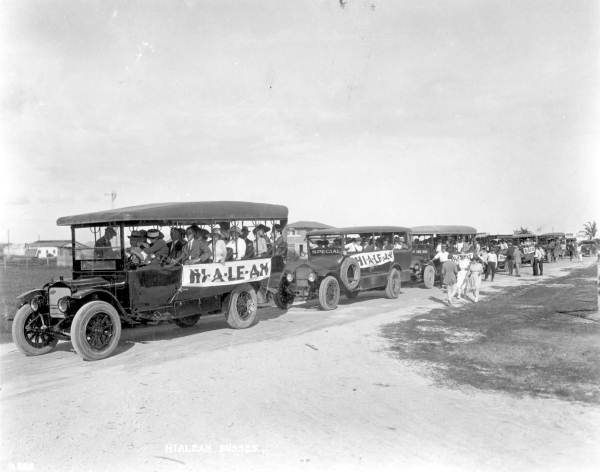
Busloads of potential home buyers make their way through the new suburban development at Hialeah (1921).
George Merrick remained confident that his idea would work if the quality of the product was exceptional and his advertising and marketing hit their marks. His aesthetic vision for Coral Gables drew heavily on his experiences traveling in the Bahamas and Cuba, as well as his affinity for Washington Irving’s Tales of the Alhambra, which had provided him with richly illustrated vistas of faraway Spain. Of course, Merrick wasn’t the only developer smitten with the Old World at that time; Addison Mizner’s Spanish-style buildings in Palm Beach also influenced the young developer’s vision for Coral Gables.
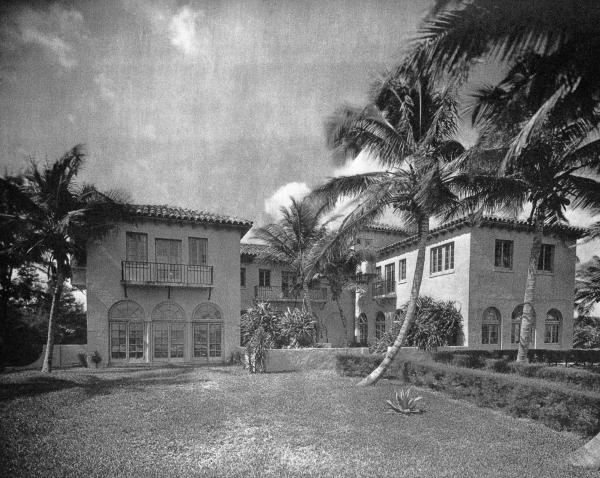
“Amado,” the home of Charles Munn in Palm Beach. Designed by architect Addison Mizner, the house reflected the Mediterranean Revival style that influenced George Merrick’s plans for Coral Gables (photo circa 1919).
Merrick began hiring architects and engineers to work out the details for the new community, and the first concept drawings appeared in February 1920. To determine the names for the streets, he opened up his copy of Irving’s Tales of the Alhambra and selected Spanish place names like Asturia, Castille, Alcazar and Aragon. He bought the Mackinac Building at 158 E. Flagler Street in Miami from John Burdine to serve as the headquarters for the Coral Gables sales and development team.
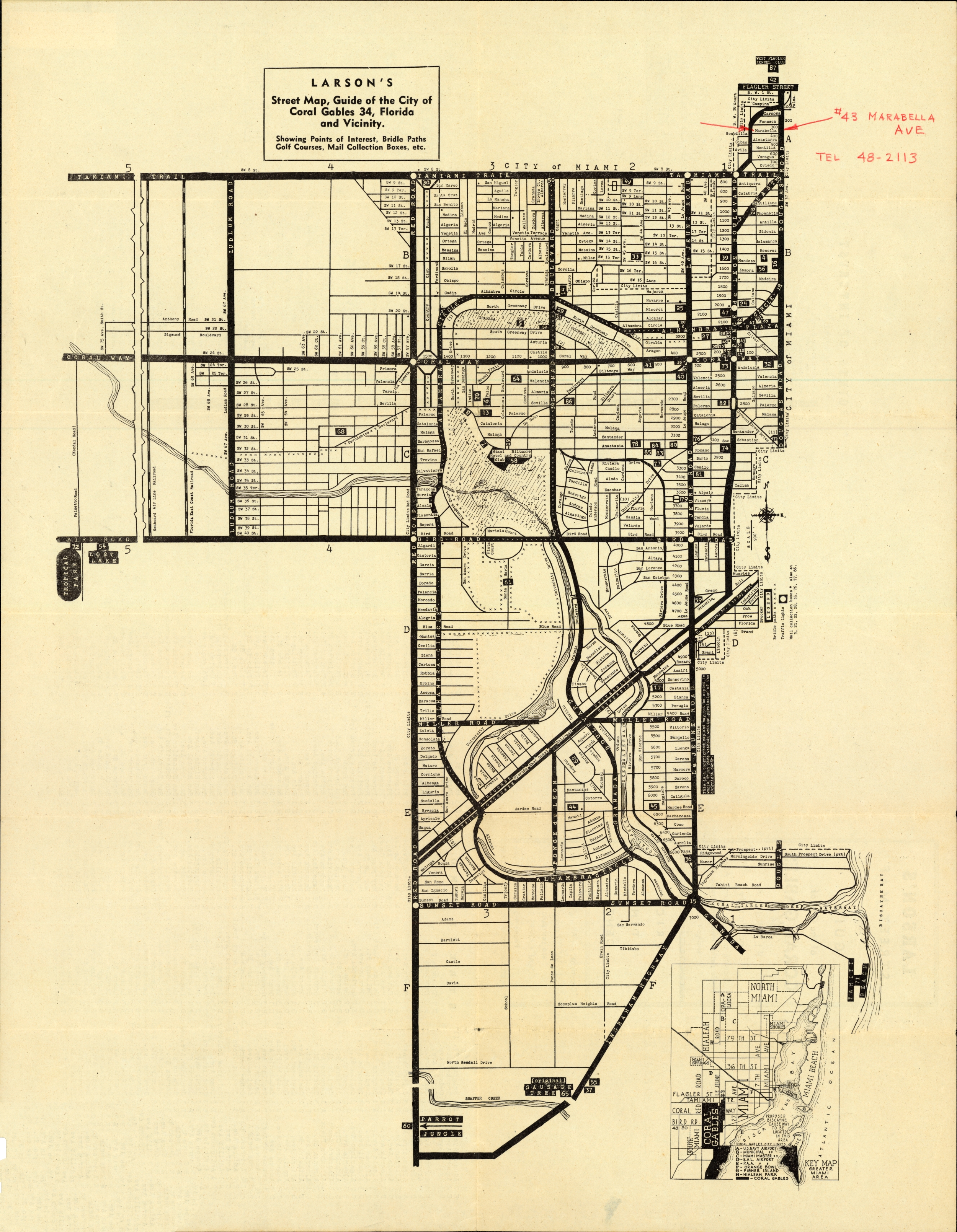
Map of Coral Gables, including additions to the original planned community site (1934). Click or tap the map to view a larger, zoomable version of it.
Merrick and his associates began auctioning off lots in the new Coral Gables subdivision on November 28, 1921. Signs urging potential buyers to “follow the Golden Galleon” were posted all along Flagler Street in Miami to lead them toward the site, and costumed Spanish caballeros helped direct traffic to the original entrance to the development via Granada Boulevard.
The public response was overwhelmingly positive; over 5,000 people crowded into the unfinished subdivision to participate in the auction. Dr. Edward E. “Doc” Dammers, who Merrick had hired to be the main auctioneer and consultant for the venture, addressed the crowd from the back of a mule-drawn wagon. As each lot was sold, Dammers sent his partner off with the buyer to finish up the paperwork while he and the wagon moved on to the next lot to repeat the process. The purchasing terms were fairly simple–buyers chose a lot and a building plan, with prices starting at $5,785. If the buyer put down $500, he could finance the rest at $60 per month. In six days’ time, Merrick’s team had sold 300 lots for more than half a million dollars. George was so delighted with the results that he decided to pledge $10,000 for a public library and $100,000 for a college. This, of course, ultimately became the University of Miami.
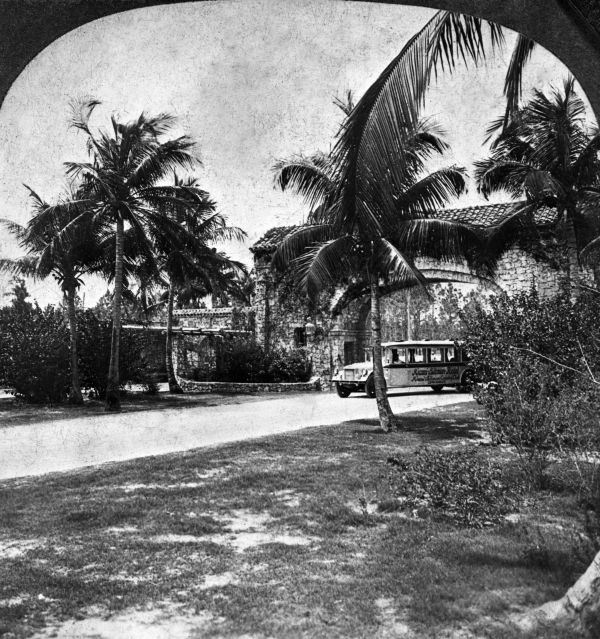
The dramatic Granada Boulevard entrance to Coral Gables, with a tour bus entering through the main archway. This gate was designed by George Merrick’s uncle, Denman Fink, and landscape architect Frank Button. It was completed in 1922 (photo also circa 1922).
Once it was properly launched, Coral Gables continued to grow at a rapid pace. George Merrick and his associates had to establish their own tile and concrete block factories to keep up the necessary supply of building materials. By 1924, the settlement had its own volunteer fire department, woman’s club, Boy Scout troop and grammar school. The next year, Coral Gables was incorporated as a town, and Doc Dammers became its first mayor. The year after that, on February 4, 1926, the cornerstone was laid for the first building of what would become the University of Miami.
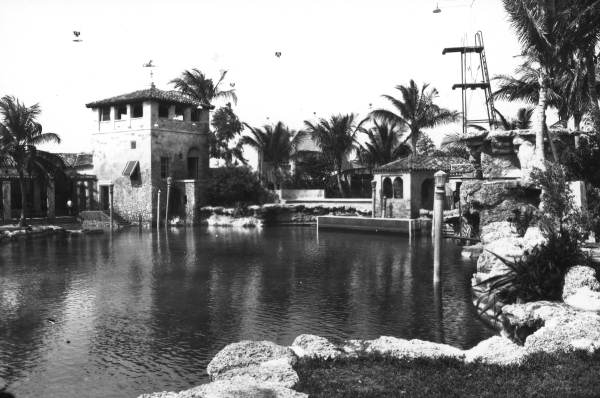
The Venetian Pool, also called the Venetian Casino, a striking feature of the original Coral Gables development. It was added to the National Register of Historic Places in 1981 (photo circa 1925).
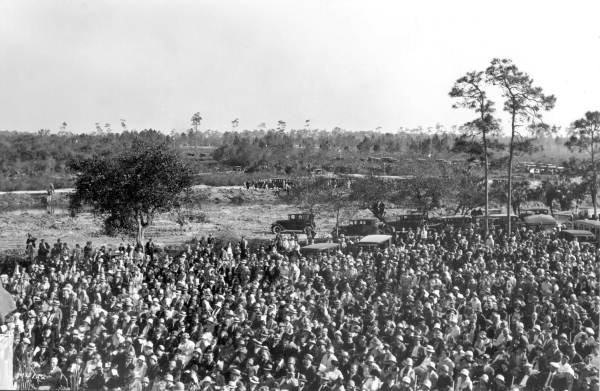
Crowd assembled for the laying of the cornerstone of the University of Miami’s first building–the Merrick Building (1926).
The stage was set for a bright future. Even the collapse of the Florida Boom in the late 1920s failed to completely arrest the growth of Coral Gables. Today, the community continues as home to the University of Miami, as well as a center of international commerce. Numerous foreign consulates are located there, as are the corporate headquarters of Bacardi, Fresh Del Monte Produce and Capital Bank Financial.
The State Archives of Florida holds an extensive collection of photographs belonging to photographer William A. Fishbaugh, who George Merrick hired to help promote Coral Gables and other real estate developments in the Miami area. Browse the William Fishbaugh Collection on Florida Memory to find more historic images of the region during and after the Florida Boom.
For a more extensive treatment of George Merrick and the development of Coral Gables, we also recommend Arvah Parks’ recent book, George Merrick, Son of the South Wind: Visionary Creator of Coral Gables, published in 2015 by the University Press of Florida.
Cite This Article
Chicago Manual of Style
(17th Edition)Florida Memory. "Miami's Master Suburb." Floridiana, 2018. https://www.floridamemory.com/items/show/341937.
MLA
(9th Edition)Florida Memory. "Miami's Master Suburb." Floridiana, 2018, https://www.floridamemory.com/items/show/341937. Accessed January 8, 2026.
APA
(7th Edition)Florida Memory. (2018, September 9). Miami's Master Suburb. Floridiana. Retrieved from https://www.floridamemory.com/items/show/341937

 Listen: The Bluegrass & Old-Time Program
Listen: The Bluegrass & Old-Time Program